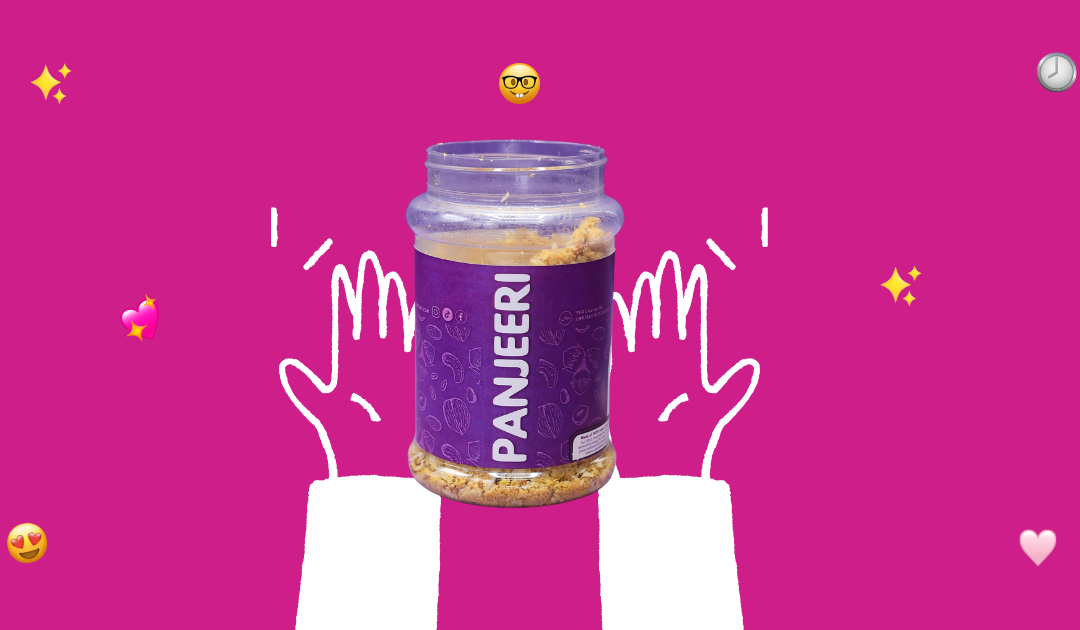What is Panjeeri? Is it a myth or is it for real? Is it just as beneficial to us as people rave about or it is just another ‘desi totka’ sold to desi moms? If you’re reading this, you’ve probably heard about Panjeeri being a superfood for new moms. The reality is that it is much more than that. Panjeeri is a home-made desi delicacy that contains all the goodness nature has to offer. Packed with all the essential nutrients, Panjeeri contains carbohydrates, proteins, micro-nutrients, and sugars. Consume it on a daily and you will see a positive change in your life for yourself.
What is panjeeri?
What is panjeeri to a new mom? Gold, pure gold. Panjeeri is a centuries-old tradition that passes down from one generation to the next. Its recipe is different in every home, but its ingredients largely remain the same. If you consume it on a daily basis in small portions, Panjeeri gives you energy, nutrients, and strength to lead a healthy and active life. Panjeeri helps new moms in getting back up on their feet, ready to take care of their newborn baby. If you are a hardworking father, Panjeeri gives you the strength to handle the daily grind, maintain your energy levels, and stay strong throughout the day. What is Panjeeri to you might be different for someone else. It depends on how you consume it, and what your objectives are. Regardless, Panjeeri is a fantastic traditional snack to eat, love, and enjoy.
What is Panjeeri from a historical standpoint?
Once upon a time in olden India, a sage decided to mix together some of nature’s powerful bounties together to make a dessert. Since then, millions of benefactors have been thanking the said sage for centuries. This melange of ingredients was nothing less than a masterclass because it brought together some of the most nutritious organic food offerings out there. It was so effective in its use that even now, several decades later, is still a staple in many Indian and Pakistani homes.
Panjeeri has tremendous significance as traditional remedial food. It is an heirloom recipe of our times, passed down as a cultural and family treasure and tradition from one family to another. It is a delicacy that binds so many memories and families together and continues to do so even today.
The ingredients used in Panjeeri
Panjeeri is not a difficult food to make, and yet it is full of everything good that nature has to offer. Mainly, panjeeri is a mix of easily available dried fruits, desi ghee as a base ingredient, and suji as the main ingredient. You can also use other options such as daal (pulses) as the main ingredient, but it completely depends on your preference and taste. We’re just huge fans of semolina (suji) and love the taste of freshly made suji and desi ghee ki panjeeri.
When it comes to dried fruits, several different types of dried fruits, when thrown together, make delicious panjeeri. Some of your favorites like almonds, dried grapes (kishmish), edible gum (goond), dried dates and kamar kass are used to make Panjeeri. You can also throw other dried fruits that you particularly like into the mix. Add a few spoons of sugars and voila – a fresh batch of warm, delicious, and scrumptious Panjeeri is ready.
There are several different types of panjeeri that you can make. This depends on the ingredients that you use while cooking. If you are diabetic or are looking to avoid sugar, making sugar-free panjeeri might be best. Advocates of desi traditions can add shakkar into the mix also. At the end of the day, it really depends on how you want to satisfy your taste buds. Check the complete list of ingredients here.
What is Panjeeri used for?
Just as with most traditional foods, Panjeeri is another that has remained under the radar across many homes and families. It is just another example of the countless hidden organic food treasures that so many of us are in the dark about.
What is Panjeeri used for? The answer that most people give would instantly point towards pregnant women, postpartum care, etc. There is very little doubt regarding just how useful it is after a woman gives birth. Panjeeri contains all the necessary nutrients that a new mom requires in order to rehabilitate. It aids in the initiation of lactation and helps the women to heal internally.
Restricting Panjeeri to postpartum care would be severely undermining it because it is useful in so many other ways. It is very effective to ward off the cold in the chilly winters in most parts of the country. It is also great as an evening snack and as a general dietary supplement. Most gym goers will be glad to hear that it contains essential proteins and other nutrients that make it great as a post-workout food. Add it to your protein shake and build upon those gains.
Best time to eat panjeeri
As per our traditional custom, the best time to eat panjeeri is immediately after a woman gives birth to her child. Used as a post-partum super-food, Panjeeri is known to cure post-childbirth issues in new mothers. What is panjeeri if not useful, eh? Panjeeri helps new moms recover their energy after giving birth and in the recovery of muscles in the body. It gives mothers the energy to take care of their newborn babies, feed them, and nurture them. It is an immunity booster, and helps in the development of breast milk and in the recovery of the woman’s uterus.
Panjeeri is useful in different ways at different times. Panjeeri is a neat way to ward off the cold in the winter because it is very warm in nature and helps keep the body warm. In addition, it is useful as a post-workout supplement because of its protein-rich ingredients.
We love panjeeri made from suji – Here’s why
Suji or semolina is one of the main ingredients of our Panjeeri. Well, for starters, Pakistani just love the taste of suji if different desi foods – our beloved Barfi is the perfect example. Since we have all developed a taste for suji, Panjeeri just tastes better when made in suji.
Panjeeri made from daal is equally delicious, if you have the taste for it. Daal panjeeri is mostly made from chickpea lentils, or daal channa as we normally call it. All other ingredients are the same – just daal is added instead of suji. Panjeeri made from daal brings with it all of nature’s benefits that it has given to pulses and lentils. At the same time, we still prefer panjeeri made from suji.
Suji, or semolina, is rich in folates and folic acids, which are particularly useful for pregnant women. It also carries with it notable other nutrients like vitamins and proteins that make it such a healthy addition in panjeeri.
As discussed earlier, there is much, much more to Panjeeri than meets the eye. Let us now explore Panjeeri in greater detail. Perhaps this would help us understand just how we can reap the full benefits of such a rich bounty bestowed upon us by nature.

